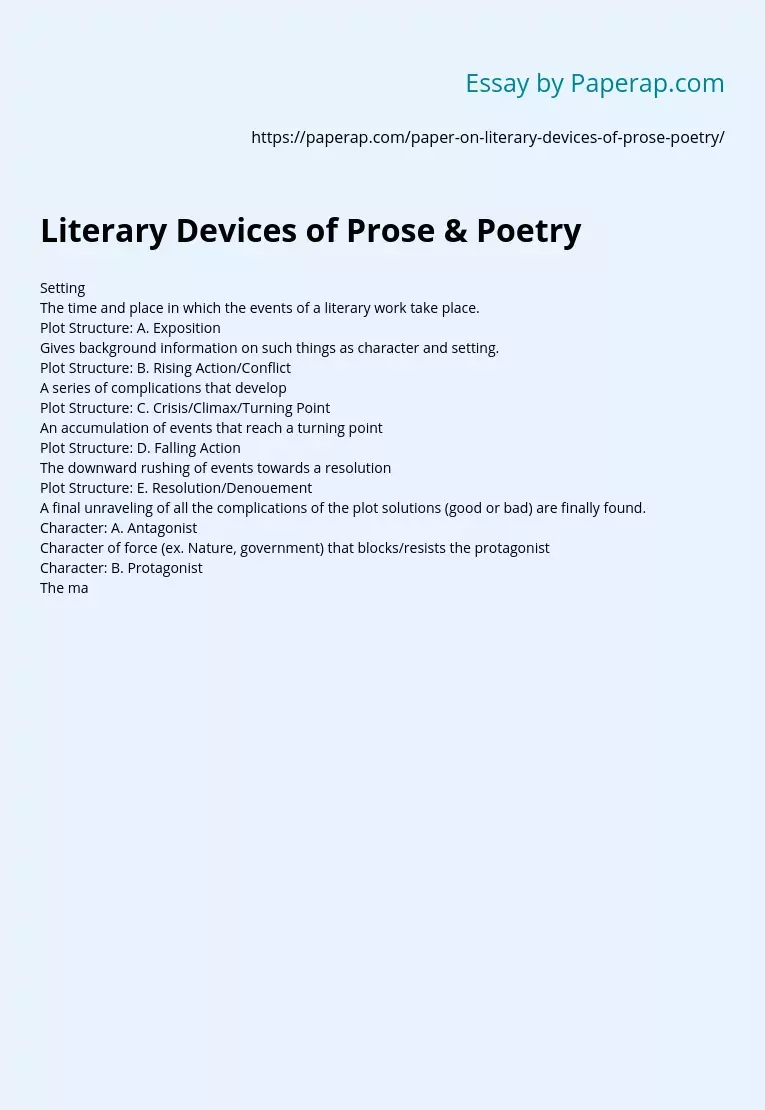Literary Devices of Prose & Poetry
Essay,
Pages 4 (788 words)
Views
82
Setting
The time and place in which the events of a literary work take place.
Plot Structure: A. Exposition
Gives background information on such things as character and setting.
Plot Structure: B. Rising Action/Conflict
A series of complications that develop
Plot Structure: C. Crisis/Climax/Turning Point
An accumulation of events that reach a turning point
Plot Structure: D. Falling Action
The downward rushing of events towards a resolution
Plot Structure: E. Resolution/Denouement
A final unraveling of all the complications of the plot solutions (good or bad) are finally found.
Character: A. Antagonist
Character of force (ex. Nature, government) that blocks/resists the protagonist
Character: B. Protagonist
The main character of a story. Sets the plot in motion and involved in story’s conflict. Round Dynamic.
Character: C. Round
Developed characters where many sides of their personality (3-4 Traits) are seen.
Character: D. Flat
Characters that are sketched out for us and not fully developed (1-2 Traits). These characters are one dimensional.
Character: E. Dynamic
A character who changes over the course of a story
Character: F. Static
A character that remains the same over the course of a story
Character: G. Stock
A character that relies on cultural stereotypes for its personality. Are instantly recognizable to members of a given culture.
Foil
A character who acts as a contrast to another character
Characterization: A. Direct
The author tells us explicitly what kind of person the character is.
Characterization: B. Indirect
The author makes the reader figure out the persona of the character through…(Speech, appearance, thoughts, actions, interactions/reactions)
Conflict: A. Internal
1. Individual vs. Self
2. Moral dilemma?
3. Course of action?
2. Moral dilemma?
3. Course of action?
Conflict: B. External
1. Individual vs. Man
2. Individual vs. Society
3. Individual vs. Nature
4. Individual vs. Greater Force
2. Individual vs. Society
3. Individual vs. Nature
4. Individual vs. Greater Force
Point of View: A. Participant First Person
Told from the character’s point of view
Point of View: B. Non-Participant Narrator Third Person Limited Omniscient
Narrator may go into only one character’s thoughts
Point of View: C. Non-Participant Narrator
i. Third person omniscient-Narrator may go into any of the character’s thoughts. All seeing, all knowing.
Narrative Reliability: 1. First person
biased
Narrative Reliability: 2. Narrator
unbiased
Symbol
Something that represents itself and something beyond itself as well
Tone
Attitude (Emotion) a writer takes toward the audience, a subject, or a character
Theme
A main idea or controlling idea that gives us insight about human life
Mood
The atmosphere created by the setting and actions of people and characters in it. It also relates to how the reader emotionally responds to these elements like sadness for a tragedy.
Irony
Contrast or discrepency between expectation and reality (Verbal, Situational, Dramatic)
Irony: 1. Verbal
When a writer or speaker says one thing but means something entirely different.
Irony: 2. Situational
A discrepency between the expected result and the accual result.
Irony: 3. Dramatic
The audience knows what will happen before the character.
Diction
Word choice
Dialect
When the speech of two groups speaking the same language is different.
*Causes-isolation or separation
a. Natural-Geography, b. Social-hostility, economic
*Causes-isolation or separation
a. Natural-Geography, b. Social-hostility, economic
Satire
A literary manner that blends a critical attitude with humor and wit to poke fun at human institutions or humanity for needed improvements.
Biography
A detailed description or account of someone’s life.
Autobiography
An account of the life of a person, written by its subject
Slang
Special terms or speech developed for professions, sports, localities, or among people with common interests
Vernacular/Colloquial
A characteristic language of a particular group (as among thieves); “They don’t speak our lingo.”
Figurative Language: A. Repetition
Reiterating a word or phrase, or rewording the same idea to secure emphasis–to reinforce it.
Figurative Language: B. Parallelism
Repeating the structural arrangement of parts of a sentence or parts of a paragraph to secure emphasis.
Figurative Language: C. Antithesis
A figure of speech characterized by strongly contrasting words, clauses, sentences, or ideas.
Figurative Language: D. Hyperbole
A figure of speech in which conscious exaggeration is used without the intent of literal persuasion.
Figurative Language: E. Metaphorical
i. Metaphor-a direct comparison between two unlike things.
Figurative Language: F. Simile
A comparison of two unlike things using the words “Like” or “As”.
Figurative Language: G. Allusion
Reference to a statement, a person, a place, or an event for literature.
Figurative Language: H. Personification
A figure of speech that endows animals, inanimate objects or ideas with human-like characteristics.
Figurative Language: I. Imagery
A collection of images
Meter: A. Free Verse
Poetry that does not have a regular rhyme scheme. These poets capture the natural rhythms or ordinary speech.
Meter: B. Blank Verse
Unrhymed iambic pentameter
Paraphrasing
A restatement of an idea in such a way as to retain the meaning while changing the diction and form.
Voice
Refers to the controlling presence of “authority” behind the characters, narrators, and personae of literature.
Literary Devices of Prose & Poetry. (2017, Nov 27). Retrieved from https://paperap.com/paper-on-literary-devices-of-prose-poetry/
